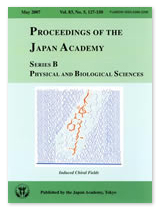About the Cover
Vol. 83 No. 5 (2007)
Since the discovery of enantiomerism by Pasteur in 1848, discrimination of optical isomers has always been one of major subjects in the fields of chemistry and biology because optical purities of substances with asymmetries are critical for the evaluation of biological activities. In the existing methods, it has been recognized that the most reliable one is the diastereomer method. Until recently, however, this widely used method has a fatal defect that it is impossible to discriminate diastereomers with chiral centers separated by more than four bonds. In order to solve this, Dr. Hiroshi Ohrui hypothesized as follows. If diastereomers were provided with a helically chiral conformation by the chirality of labeling reagent, the other chiral centers in the diastereomers would be involved in the helically chiral molecule, and therefore, even remote chiral centers more than four bonds would be differentiated.
In fact, when he designed a fluorescent and chiral labeling reagent with anthracenecarboximido-propanol unit using the gauche effect discovered through his carbohydrate research, remote differentiation of more than ten bonds became possible at a femto mole level. The anthracene unit was thought to be essential not only for the sensitivity as fluorescent reagent but for the key CH-π interaction with long methylene chain. In the second generation, by fixing the gauche effect-moiety with cyclohexane skeleton, the resolution was much improved, and longer and more complex molecules became separable.
Finally, he reached to the reagent with both polar sugar- and anthracene-moieties which could even resolve extremely long chain (C-24) and discriminate a complex molecule with eight diastereomers of separated asymmetric centers and many other analogs. This revolution of the analytic method on discrimination of optical isomers would be widely employed in related areas and should contribute extremely to further development. These results are hardly explained only by the initial hypothesis of the gauche effect and CH-π interaction. Dr. Ohrui now proposes the following hypothesis to explain this unusually high level of resolution.
“Induced Chiral Fields”:
The interaction of the flowing large helically chiral molecules having a long methylene chain and an anthracene-2,3-dicarboximido groups with the methylene chains of reversed-phase column will chirally bend and/or twist the methylene chains of the reversed phase to create the appearance of new chiral fields. Thus, the originally achiral reversed-phase column could behave as the chiral column.
Guest Professor, The Kitasato Institute
Professor, Teikyo Heisei University




